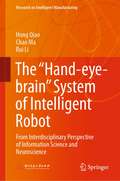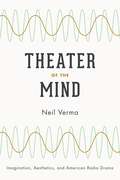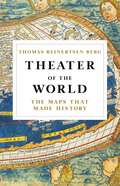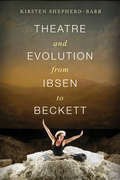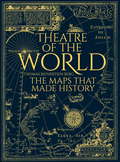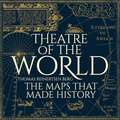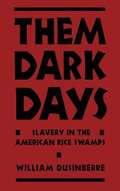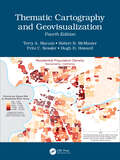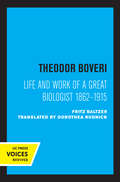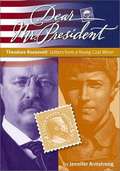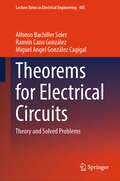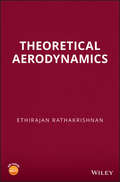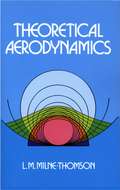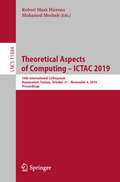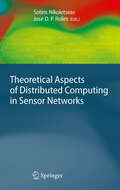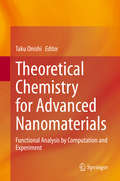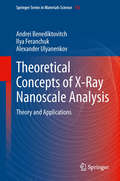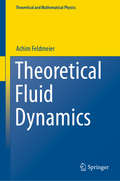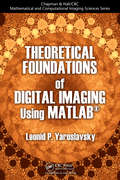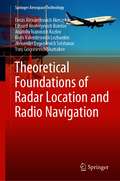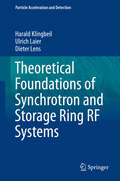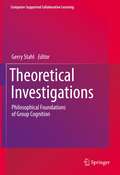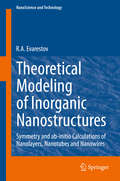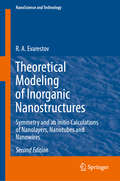- Table View
- List View
The “Hand-eye-brain” System of Intelligent Robot: From Interdisciplinary Perspective of Information Science and Neuroscience (Research on Intelligent Manufacturing)
by Chao Ma Rui Li Hong QiaoThis book reports the new results of intelligent robot with hand-eye-brain, from the interdisciplinary perspective of information science and neuroscience. It collects novel research ideas on attractive region in environment (ARIE), intrinsic variable preserving manifold learning (IVPML) and biologically inspired visual congnition, which are theoretically important but challenging to develop the intelligent robot. Furthermore, the book offers new thoughts on the possible future development of human-inspired robotics, with vivid illustrations. The book is useful for researchers, R&D engineers and graduate students working on intelligent robots.
Theater of the Mind: Imagination, Aesthetics, and American Radio Drama
by Neil VermaFor generations, fans and critics have characterized classic American radio drama as a “theater of the mind.” This book unpacks that characterization by recasting the radio play as an aesthetic object within its unique historical context. In Theater of the Mind, Neil Verma applies an array of critical methods to more than six thousand recordings to produce a vivid new account of radio drama from the Depression to the Cold War.In this sweeping exploration of dramatic conventions, Verma investigates legendary dramas by the likes of Norman Corwin, Lucille Fletcher, and Wyllis Cooper on key programs ranging from The Columbia Workshop, The Mercury Theater on the Air, and Cavalcade of America to Lights Out!, Suspense, and Dragnet to reveal how these programs promoted and evolved a series of models of the imagination.With close readings of individual sound effects and charts of broad trends among formats, Verma not only gives us a new account of the most flourishing form of genre fiction in the mid-twentieth century but also presents a powerful case for the central place of the aesthetics of sound in the history of modern experience.
Theater of the World: The Maps that Made History
by Thomas Reinertsen BergA beautifully illustrated full-color history of mapmaking across centuries-- a must-read for history buffs and armchair travelers. Theater of the World offers a fascinating history of mapmaking, using the visual representation of the world through time to tell a new story about world history and the men who made it. Thomas Reinertsen Berg takes us all the way from the mysterious symbols of the Stone Age to Google Earth, exploring how the ability to envision what the world looked like developed hand in hand with worldwide exploration. Along the way, we meet visionary geographers and heroic explorers along with other unknown heroes of the map-making world, both ancient and modern. And the stunning visual material allows us to witness the extraordinary breadth of this history with our own eye
Theatre and Evolution from Ibsen to Beckett
by Kirsten Shepherd-BarrReveals the deep, transformative entanglement among science, art, and culture in modern times
Theatre of the World: The History of Maps and the Men and Women Who Made Them
by Thomas Reinertsen Berg'Fascinating...sumptuously produced with lots of full-colour images, is a kind of potted treasury of cartographical history that gleams with pieces-of-eight-like snippets of information...this is an enthralling book, and joins the likes of Simon Garfield's On the Map and Jerry Brotton's A History of the World in Twelve Maps in the field of popular reaffirmations of the ingenuity of geography.' Travis Elborough, Spectator'A fascinating book that I will always treasure.' Sir Ranulph Fiennes 'This wonderful book is a reminder of how much careful thought was given to the shape of the world even in ancient times - the landscape, how places are related to one another. I pored over these maps for hours, imagining those minds hard at work, visualising how it all connected as a whole. Just brilliant.' Neil Oliver'Visually stunning...it's gone straight to the top of my Christmas present list.' The Bookseller'I remember how well I liked to turn the pages of my childhood atlas and travel the world to find out where countries and cities were. But there was never anything about why the maps were created - or who drew them. Theatre of the World was my big chance to tell the stories of all those men and women map makers whose amazing work deserves to be celebrated.' Thomas Reinertsen BergBeautifully illustrated and rich in detail, Theatre of the World reignites our curiosity with the world both ancient and modern. Before you could just put finger to phone to scroll Google Maps, in advance of the era of digital mapping and globes, maps were being constructed from the ideas and questions of pioneering individuals.From visionary geographers to heroic explorers, from the mysterious symbols of the Stone Age to the familiar navigation of Google Earth, Thomas Reinertsen Berg examines the fascinating concepts of science and worldview, of art and technology, power and ambitions, practical needs and distant dreams of the unknown.
Theatre of the World: The History of Maps and the Men and Women Who Made Them
by Thomas Reinertsen Berg'Visually stunning...it's gone straight to the top of my Christmas present list.' The Bookseller'I remember how well I liked to turn the pages of my childhood atlas and travel the world to find out where countries and cities were. But there was never anything about why the maps were created - or who drew them. Theatre of the World was my big chance to tell the stories of all those men and women map makers whose amazing work deserves to be celebrated.' Thomas Reinertsen BergBeautifully written and rich in detail, Theatre of the World reignites our curiosity with the world both ancient and modern. Before you could just put finger to phone to scroll Google Maps, in advance of the era of digital mapping and globes, maps were being constructed from the ideas and questions of pioneering individuals.From visionary geographers to heroic explorers, from the mysterious symbols of the Stone Age to the familiar navigation of Google Earth, Thomas Reinertsen Berg examines the fascinating concepts of science and worldview, of art and technology, power and ambitions, practical needs and distant dreams of the unknown.(P)2018 Hodder & Stoughton Limited
Them Dark Days: Slavery in the American Rice Swamps
by William DusinberreDusinberre offers both a vivid reconstruction of slavery in action and an analysis of slave culture set within a wider context of health, discipline, privilege, and psychology.
Thematic Cartography and Geovisualization
by Terry A. Slocum Robert B. McMaster Fritz C. Kessler Hugh H. HowardThis comprehensive and well-established cartography textbook covers the theory and the practical applications of map design and the appropriate use of map elements. It explains the basic methods for visualizing and analyzing spatial data and introduces the latest cutting-edge data visualization techniques. The fourth edition responds to the extensive developments in cartography and GIS in the last decade, including the continued evolution of the Internet and Web 2.0; the need to analyze and visualize large data sets (commonly referred to as Big Data); the changes in computer hardware (e.g., the evolution of hardware for virtual environments and augmented reality); and novel applications of technology. Key Features of the Fourth Edition: Includes more than 400 color illustrations and it is available in both print and eBook formats. A new chapter on Geovisual Analytics and individual chapters have now been dedicated to Map Elements, Typography, Proportional Symbol Mapping, Dot Mapping, Cartograms, and Flow Mapping. Extensive revisions have been made to the chapters on Principles of Color, Dasymetric Mapping, Visualizing Terrain, Map Animation, Visualizing Uncertainty, and Virtual Environments/Augmented Reality. All chapters include Learning Objectives and Study Questions. Provides more than 250 web links to online content, over 730 references to scholarly materials, and additional 540 references available for Further Reading. There is ample material for either a one or two-semester course in thematic cartography and geovisualization. This textbook provides undergraduate and graduate students in geoscience, geography, and environmental sciences with the most valuable up-to-date learning resource available in the cartographic field. It is a great resource for professionals and experts using GIS and Cartography and for organizations and policy makers involved in mapping projects.
Theodor Boveri: Life and Work of a Great Biologist
by Fritz BaltzerThis title is part of UC Press's Voices Revived program, which commemorates University of California Press’s mission to seek out and cultivate the brightest minds and give them voice, reach, and impact. Drawing on a backlist dating to 1893, Voices Revived makes high-quality, peer-reviewed scholarship accessible once again using print-on-demand technology. This title was originally published in 1967.
Theodore Roosevelt: Letters from a Young Coal Miner
by Jennifer ArmstrongThe Dear Mr. President series brings history alive through fictitious correspondence between a president and a young person. These thought-provoking letters provide valuable insights into important moments in American history through their portrayal of issues from other times. Although the letters are imagined, they are all based upon meticulous historical research. To capture each president's personality and the voice of the youth of each time period, the authors draw on definitive books, firsthand interviews, and other reliable sources. Elegantly designed in two colors, the books include primary source material, reproductions of actual letters, a presidential biography, U.S. postal history, timelines, and an index. The interactive Web footnotes throughout the books are a unique feature of the Dear Mr. President series. These footnotes point readers to the series Web page at winslowpress.com for further information on a particular topic. This invaluable Web page encourages individual exploration, expertly guiding visitors through the vast resources of the Internet. There they will find primary source materials, links, historical sites, interactive games, and activities.
Theorems for Electrical Circuits: Theory and Solved Problems (Lecture Notes in Electrical Engineering #485)
by Alfonso Bachiller Soler Miguel Angel González Cagigal Ramón Cano GonzálezThis book focuses on the practical application of specific theorems in solving electrical circuits. Specifically, it covers the theorems of Superposition, Thevenin, Norton, and Maximum Power Transfer. The theory is kept concise, yet all the necessary concepts are explained, and plentiful problems are solved in detail. A vast amount of figures is used for a more effective learning. All in all, this book helps undergraduate and graduate students to develop the necessary skills to solve a broad range of transient exercises. It offers a unique complementary text to classical electric circuit textbooks, for students and self-study, as well.
Theoretical Aerodynamics
by Ethirajan RathakrishnanTheoretical Aerodynamics is a user-friendly text for a full course on theoretical aerodynamics. The author systematically introduces aerofoil theory, its design features and performance aspects, beginning with the basics required, and then gradually proceeding to higher level. The mathematics involved is presented so that it can be followed comfortably, even by those who are not strong in mathematics. The examples are designed to fix the theory studied in an effective manner. Throughout the book, the physics behind the processes are clearly explained. Each chapter begins with an introduction and ends with a summary and exercises. This book is intended for graduate and advanced undergraduate students of Aerospace Engineering, as well as researchers and Designers working in the area of aerofoil and blade design. Provides a complete overview of the technical terms, vortex theory, lifting line theory, and numerical methods Presented in an easy-to-read style making full use of figures and illustrations to enhance understanding, and moves well simpler to more advanced topics Includes a complete section on fluid mechanics and thermodynamics, essential background topics to the theory of aerodynamics Blends the mathematical and physical concepts of design and performance aspects of lifting surfaces, and introduces the reader to the thin aerofoil theory, panel method, and finite aerofoil theory Includes a Solutions Manual for end-of-chapter exercises, and Lecture slides on the book's Companion Website
Theoretical Aerodynamics
by L. M. Milne-ThomsonA classic in its field, this university text and reference book has long been one of the basic works. This is the complete reprinting of the revised (1966) edition which brings the subject up to date, including a complete and probably unique chapter on conical flow round sweptback wings.After two introductory chapters on the simplifying assumptions demanded for the study and a final chapter on vectors, the author treats the material in four fairly well-defined parts: (1) two-dimensional aerofoils (two-dimensional motion, rectilinear vortices, the circular cylinder as an aerofoil, Joukowski's transformation, theory of two-dimensional aerofoils, and thin aerofoils); (2) three-dimensional aerofoils (induced velocity, aerofoils of finite aspect ratio, the lifting line theory, lifting surface theory, propellers, and wind tunnel corrections); (3) subsonic and supersonic flow (subsonic flow, supersonic flow, supersonic sweptback and delta wings); and, (4) the aircraft as a whole (simple flight problems, moments, and stability). The treatment is founded on complex variable and vector methods, both of which are explained in the self-contained text. A wealth of problems, illustrations, and cross-references add to the book's value both as a text and a reference. The only prerequisite is a knowledge of the elements of the differential and integral calculus.
Theoretical Aspects of Computing – ICTAC 2019: 16th International Colloquium, Hammamet, Tunisia, October 31 – November 4, 2019, Proceedings (Lecture Notes in Computer Science #11884)
by Mohamed Mosbah Robert Mark HieronsThis book constitutes the refereed proceedings of the 16th International Colloquium on Theoretical Aspects of Computing, ICTAC 2019, held in Hammamet, Tunisia, in October/November 2019.The 17 revised full papers presented together with 2 keynote papers and 1 industrial paper were carefully reviewed and selected from 138 submissions.The papers are grouped in topical sections on models and transition systems; real-time and temporal logics; verification and concurrency; privacy and security; equations, types, and programming languages.
Theoretical Aspects of Distributed Computing in Sensor Networks
by José D.P. Rolim Sotiris NikoletseasWireless ad hoc sensor networks has recently become a very active research subject. Achieving efficient, fault-tolerant realizations of very large, highly dynamic, complex, unconventional networks is a real challenge for abstract modelling, algorithmic design and analysis, but a solid foundational and theoretical background seems to be lacking. This book presents high-quality contributions by leading experts worldwide on the key algorithmic and complexity-theoretic aspects of wireless sensor networks. The intended audience includes researchers and graduate students working on sensor networks, and the broader areas of wireless networking and distributed computing, as well as practitioners in the relevant application areas. The book can also serve as a text for advanced courses and seminars.
Theoretical Chemistry for Advanced Nanomaterials: Functional Analysis by Computation and Experiment
by Taku OnishiThis book collects recent topics of theoretical chemistry for advanced nanomaterials from the points of view of both computational and experimental chemistry. It is written for computational and experimental chemists, including undergraduate students, who are working with advanced nanomaterials, where collaboration and interplay between computation and experiment are essential.After the general introduction of nanomaterials, several computational approaches are explained in Part II. Each chapter presents not only calculation methods but also concrete calculation results for advanced nanomaterials. Hydride ion conducting nanomaterials, high-k dielectric nanomaterials, and organic electronics are focused on. In Part III, the interplay between computational and experimental approaches is explained. The chapters show calculation results, combined with corresponding experimental data. Dimensionality of nanomaterials, electronic structure of oligomers and nanorods, carbon nanomaterials, and the electronic structure of a nanosized sandwich cluster is looked at carefully. In Part IV, functionality analysis is explained from the point of view of the experimental approach. The emphasis is on the mechanism of photoluminescence and hydrogen generation using silicon nanopowder, the superionic conducting mechanism of glass ceramics, nanoclusters formation on the surface of metal oxides, and the magnetic property of an organic one-dimensional nanochannel. Finally, forthcoming theoretical methods for excited states and quantum dynamics are introduced in Part V.
Theoretical Concepts of X-Ray Nanoscale Analysis: Theory, Experiments and Applications
by Ilya Feranchuk Alexander Ulyanenkov Andrei BenediktovichThis book provides a concise survey of modern theoretical concepts of X-ray materials analysis. The principle features of the book are: basics of X-ray scattering, interaction between X-rays and matter and new theoretical concepts of X-ray scattering. The various X-ray techniques are considered in detail: high-resolution X-ray diffraction, X-ray reflectivity, grazing-incidence small-angle X-ray scattering and X-ray residual stress analysis. All the theoretical methods presented use the unified physical approach. This makes the book especially useful for readers learning and performing data analysis with different techniques. The theory is applicable to studies of bulk materials of all kinds, including single crystals and polycrystals as well as to surface studies under grazing incidence. The book appeals to researchers and graduate students alike.
Theoretical Fluid Dynamics (Theoretical and Mathematical Physics)
by Achim FeldmeierThis textbook gives an introduction to fluid dynamics based on flows for which analytical solutions exist, like individual vortices, vortex streets, vortex sheets, accretions disks, wakes, jets, cavities, shallow water waves, bores, tides, linear and non-linear free-surface waves, capillary waves, internal gravity waves and shocks. Advanced mathematical techniques ("calculus") are introduced and applied to obtain these solutions, mostly from complex function theory (Schwarz-Christoffel theorem and Wiener-Hopf technique), exterior calculus, singularity theory, asymptotic analysis, the theory of linear and nonlinear integral equations and the theory of characteristics.Many of the derivations, so far contained only in research journals, are made available here to a wider public.
Theoretical Foundations of Digital Imaging Using MATLAB (Chapman & Hall/CRC Mathematical and Computational Imaging Sciences Series)
by Leonid P. YaroslavskyHelping readers master digital imaging, this text presents a unified theoretical basis for understanding and designing methods of imaging and image processing. Designed for newcomers to imaging science and engineering, the book covers the subject in its entirety, from image formation to image perfecting. The author avoids using heavy mathematics and derives all formulas in full detail. To facilitate a deeper understanding of the major results, the book includes a number of exercises supported by MATLAB programs.
Theoretical Foundations of Radar Location and Radio Navigation (Springer Aerospace Technology)
by Yury Grigorievich Shatrakov Denis Alexandrovich Akmaykin Eduard Anatolyevich Bolelov Anatoliy Ivanovich Kozlov Boris Valentinovich Lezhankin Alexander Evgenievich SvistunovThe book represents a study guide reciting theoretical basics of radar location and radio navigation systems of air and sea transport. This is the distinctive feature of this study guide.The study guide states the principal physics of radar location and radio navigation, main measuring methods of proper and relative movement parameters of an object, tactical and technical characteristics of radar location and radio navigation systems, including examining issues on radiofrequency signals detection and its parameters estimation against background and interference of different type, filtering, combined detection and rating of signals, signals resolution and classification. The structural and functioning principles of the current and advanced radar location and radio navigation systems of air and sea transport are represented in the study guide with an adequate completeness. The study guide features the result of years long lecturing on radar location and radio navigation theoretical courses at the Moscow State Technical University of Civil Aviation and G.I.Nevelskiy Maritime State Technical Academy. The study guide is designated for students of radio-engineering specialties in area of air and sea transport. The study guide can be useful for radio engineers working in the field of air and maritime transport, and for graduate students and academic researchers as well.
Theoretical Foundations of Synchrotron and Storage Ring RF Systems (Particle Acceleration and Detection)
by Harald Klingbeil Ulrich Laier Dieter LensThis is an open access book.This course-tested text is an ideal starting point for engineers and physicists entering the field of particle accelerators. The fundamentals are comprehensively introduced, derivations of essential results are provided and a consistent notation style used throughout the book allows readers to quickly familiarize themselves with the field, providing a solid theoretical basis for further studies.Emphasis is placed on the essential features of the longitudinal motion of charged particle beams, together with the corresponding RF generation and power amplification devices for synchrotron and storage ring systems. In particular, electrical engineering aspects such as closed-loop control of system components are discussed.The book also offers a valuable resource for graduate students in physics, electronics engineering, or mathematics looking for an introductory and self-contained text on accelerator physics.
Theoretical Insights into the Electrochemical Properties of Ionic Liquid Electrolytes in Lithium-Ion Batteries
by Leila Maftoon-AzadThis book provides a concise overview of the use of ionic liquids as electrolytes in lithium-ion batteries (LIBs) from a theoretical and computational perspective. It focuses on computational studies to understand the behavior of lithium ions in different ionic liquids and to optimize the performance of ionic liquid-based electrolytes. The main features of the book are as follows:• Provides a thorough understanding of the theoretical and computational aspects of using ionic liquids as electrolytes in LIBs, including the evaluation and reproducibility of the theoretical paths.• Covers various computational methods such as density functional theory, molecular dynamics, and quantum mechanics that have been used to study the behavior of lithium ions in different solvents and to optimize the performance of ionic liquid-based electrolytes.• Discusses recent advances such as new computational methods for predicting the properties of ionic liquid-based electrolytes, new strategies for improving the stability and conductivity of these electrolytes, and new approaches for understanding the kinetics and thermodynamics of redox reactions with ionic liquids.• Suggests how theoretical insights can be translated into practical applications for improving performance and safety.This monograph will be of interest to engineers working on LIB optimization.
Theoretical Investigations: Philosophical Foundations of Group Cognition (Computer-Supported Collaborative Learning Series #18)
by Gerry StahlComputers have transformed how we think, discuss and learn—as individuals, in groups, within cultures and globally. However, social media are problematic, fostering flaming, culture wars and fake news. This volume presents an alternative paradigm for computer support of group thinking, collaborative learning and joint knowledge construction. This requires expanding concepts of cognition to collectivities, like collaborative groups of networked students. Theoretical Investigations explores the conditions for group cognition, supplying a philosophical foundation for new models of pedagogy and methods to analyze group interaction. Twenty-five self-contained investigations document progress in research on computer-supported collaborative learning (CSCL)—both in Stahl’s own research and during the first decade of the CSCL journal.The volume begins with two new reflections on the vision and theory that result from this research. Representing both ethnomethodological and social-constructivist research paradigms, the investigations within this volume comprise a selection of seminal and influential articles and critical commentaries that contribute to an understanding of concepts and themes central to the CSCL field. The book elaborates an innovative theory of group cognition and substantiates the pedagogical potential of CSCL. Theoretical Investigations: Philosophical Foundations of Group Cognition is essential as a graduate text for courses in educational theory, instructional design, learning and networked technologies. The investigations will also appeal to researchers and practitioners in those areas.
Theoretical Modeling of Inorganic Nanostructures
by R. A. EvarestovThis book deals with the theoretical and computational simulation of monoperiodic nanostructures for different classes of inorganic substances. These simulations are related to their synthesis and experimental studies. A theoretical formalism is developed to describe 1D nanostructures with symmetric shapes and morphologies. Three types of models are considered for this aim: (i) nanotubes (rolled from 2D nanolayers and described within the formalism of line symmetry groups); (ii) nanoribbons (obtained from 2D nanolayers by their cutting along the chosen direction of translation); (iii) nanowires (obtained from 3D lattice by its sectioning along the crystalline planes parallel to the chosen direction of translation). Quantum chemistry ab-initio methods applied for LCAO calculations on electronic and vibrational properties of 1D nanostructures are thoroughly described. Understanding of theoretical aspects presented here enlarges the possibilities for synthesis of monoperiodic nanostructures with predictable morphology and better interpretation of their properties.
Theoretical Modeling of Inorganic Nanostructures: Symmetry and ab initio Calculations of Nanolayers, Nanotubes and Nanowires (NanoScience and Technology)
by R. A. EvarestovThis book summarizes the state of the art in the theoretical modeling of inorganic nanostructures. Extending the first edition, published in 2015, it presents applications to new nanostructured materials and theoretical explanations of recently discovered optical and thermodynamic properties of known nanomaterials. It discusses the developments in theoretical modeling of nanostructures, describing fundamental approaches such as symmetry analysis and applied calculation methods. The book also examines the theoretical aspects of many thermodynamic and the optical properties of nanostructures. The new edition includes additional descriptions of the theoretical modeling of nanostructures in novel materials such as the V2O5 binary oxide, ZnS, CdS, MoSSe and SnS2.
